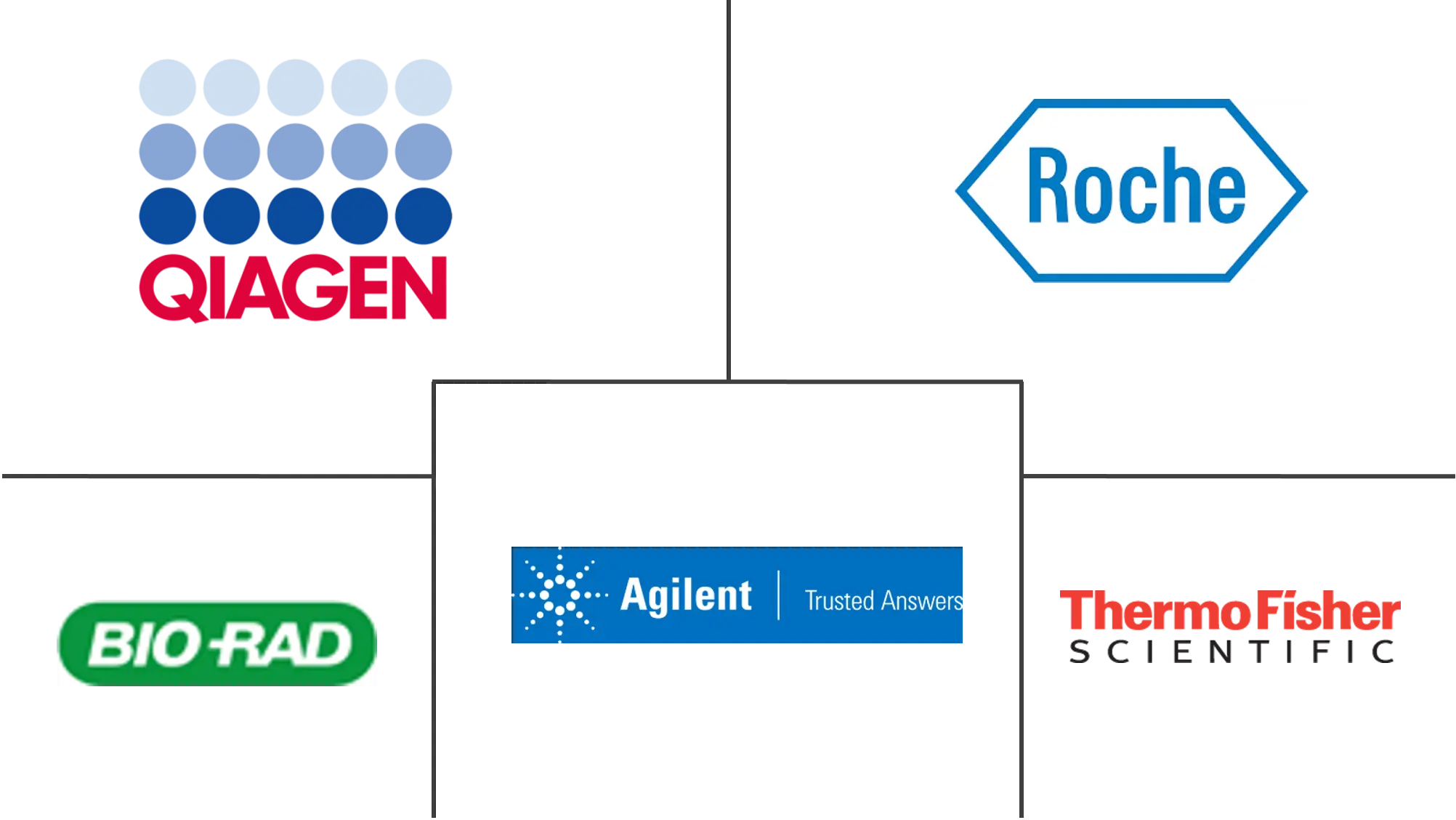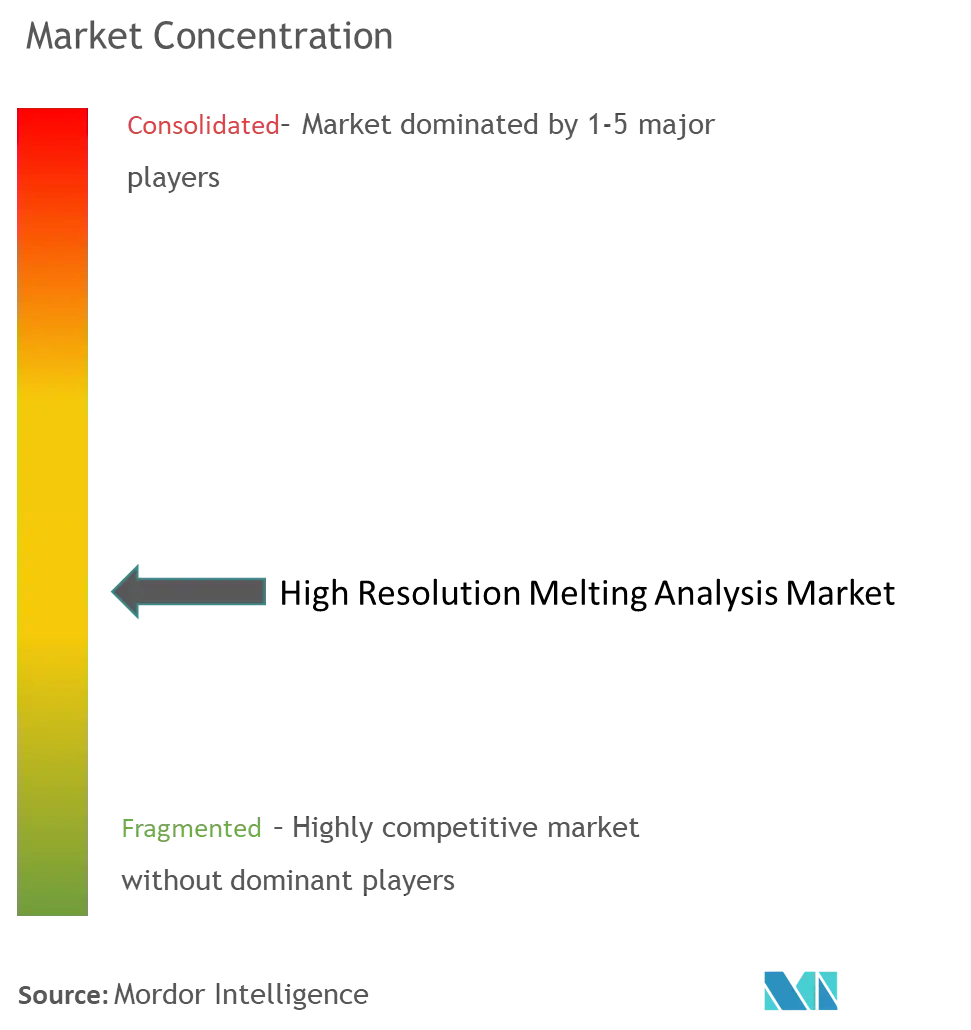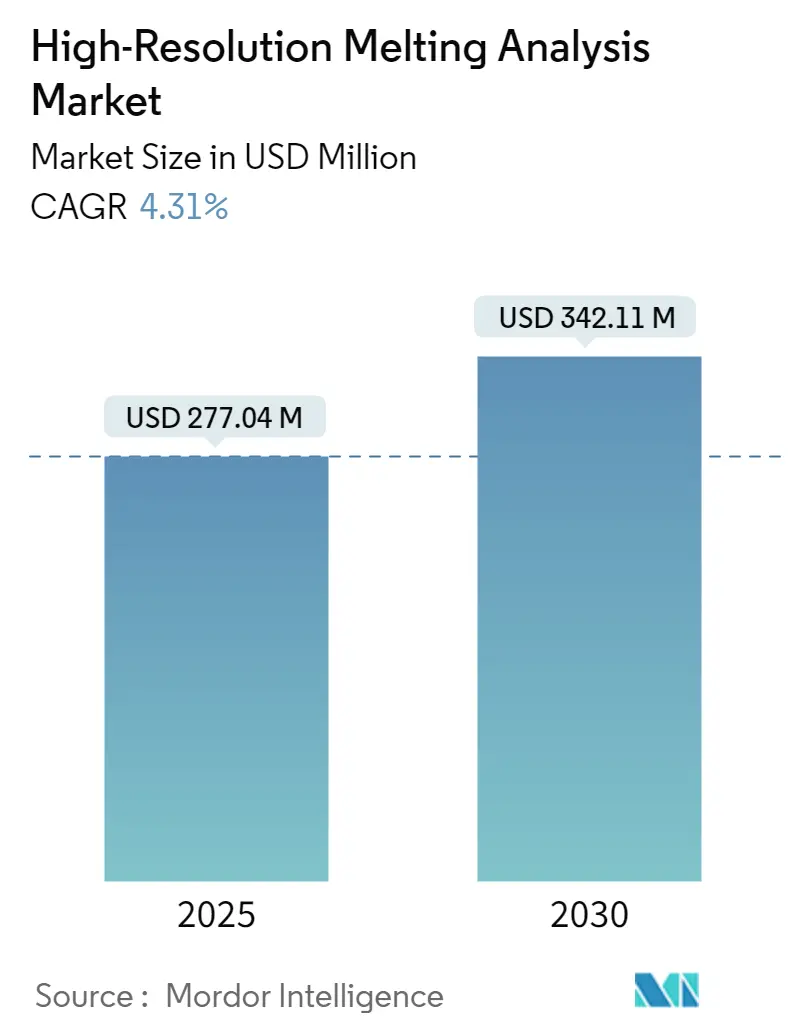
High-Resolution Melting Analysis Market Analysis
The High-Resolution Melting Analysis Market size is estimated at USD 277.04 million in 2025, and is expected to reach USD 342.11 million by 2030, at a CAGR of 4.31% during the forecast period (2025-2030).
The High-Resolution Melting (HRM) analysis is one of the novel techniques that help researchers understand the variations in nucleic acid sequences. Therefore, this technique was widely used during the COVID-19 pandemic. The HRM analysis is used to differentiate the various types of viruses and their composition. The researchers used HRM analysis to discriminate between the SARS-CoV-2 Omicron variants BA.1 and BA.2. Similarly, mutations in the coronavirus were studied with the help of HRM analysis during the pandemic. As per the September 2022 data published by Biochemistry and Biophysics Journal, it was observed that HRM analysis played a key role while differentiating between various strains of the coronavirus. It also contributed largely to understanding the characteristics of the coronavirus and its nuclear composition. Hence, with the effectiveness of HRM analysis, it is believed that the market studied was positively affected during the pandemic. Moreover, even after the pandemic, there is a growing use of HRM analysis which may drive market growth in the post-pandemic era.
The primary factor contributing to the market's growth is the increase in genetic disorders and infectious diseases. According to the WHO 2021 data, approximately 50,000 people die daily from contagious diseases. 30 new diseases have surfaced in the last 20 years, threatening the health of hundreds of millions of people. The rising burden of infectious diseases globally contributes mainly to market growth. Furthermore, the growing usage of HRM (High-Resolution Melting) in identifying pathogens and the advantages of HRM over other genotyping techniques are boosting the market growth. However, the HRM analysis's technical limitations are the market growth's major drawback.
Furthermore, the increasing occurrence of rare genetic diseases is augmenting the demand for novel techniques, such as HRM analysis, to understand the cause of the disease and provide better treatments. The research suggests that around 70% of rare diseases have genetic causes. Data published by Research Centre for Medical Genetics in August 2021 indicates that there were more than 45,000 people across the rural areas of Europe with rare hereditary diseases. Similarly, as per the Orphanet portal of rare diseases, around 10,500 rare diseases are registered worldwide as of 2022. With an increasing rare genetic disease burden, it is expected that the use of HRM analysis will increase, which is believed to propel market growth.
However, technical limitations associated with HRM analysis are expected to hinder market growth to some extent.
High-Resolution Melting Analysis Market Trends
SNP Genotyping Expected to Witness Strong Growth
SNP genotyping is a technique that analyzes genomic sequence variations. These single-base substitutions are typically detected using real-time PCR, microarrays, or next-generation sequencing (NGS) techniques.
Genomics is widening its range of applications in biotechnology and social science. For instance, the genetic diversity of a population or the heterogeneity of an individual for any hereditary condition with a recessive inheritance pattern can be used to predict the health and conservation of the population. This data can also help determine the effects of evolutionary processes and pick up genetic patterns of a specific population, including human and animal life.
Additionally, the increasing prevalence of new infectious, chronic, and other types of diseases will boost the market's growth. For instance, as per the GLOBOCAN 2020 report that estimated the incidence and mortality of 36 cancers in 185 countries globally, there were an estimated 19.3 million new cases of cancer and about 10 million deaths due to cancer across the world.
Translational research has revolutionized the treatment of different chronic and fatal diseases leading to the rise in demand and acceptance of personalized and precision medicine. These treatment therapies have opened a whole new application area for SNP genotyping as the medicine or therapies are developed per the patient's genomic structure, which requires the analysis of the patient's genome sequence first. The National Cancer Institute of the United States webcasts a report every year that represents the development of a new and advanced approach for analyzing tumors, which holds the potential to bring precision medicine to a broader range of people. Therefore, with the rising genomics and SNP genotyping methods, HRM analysis is expected to increase in the coming years.
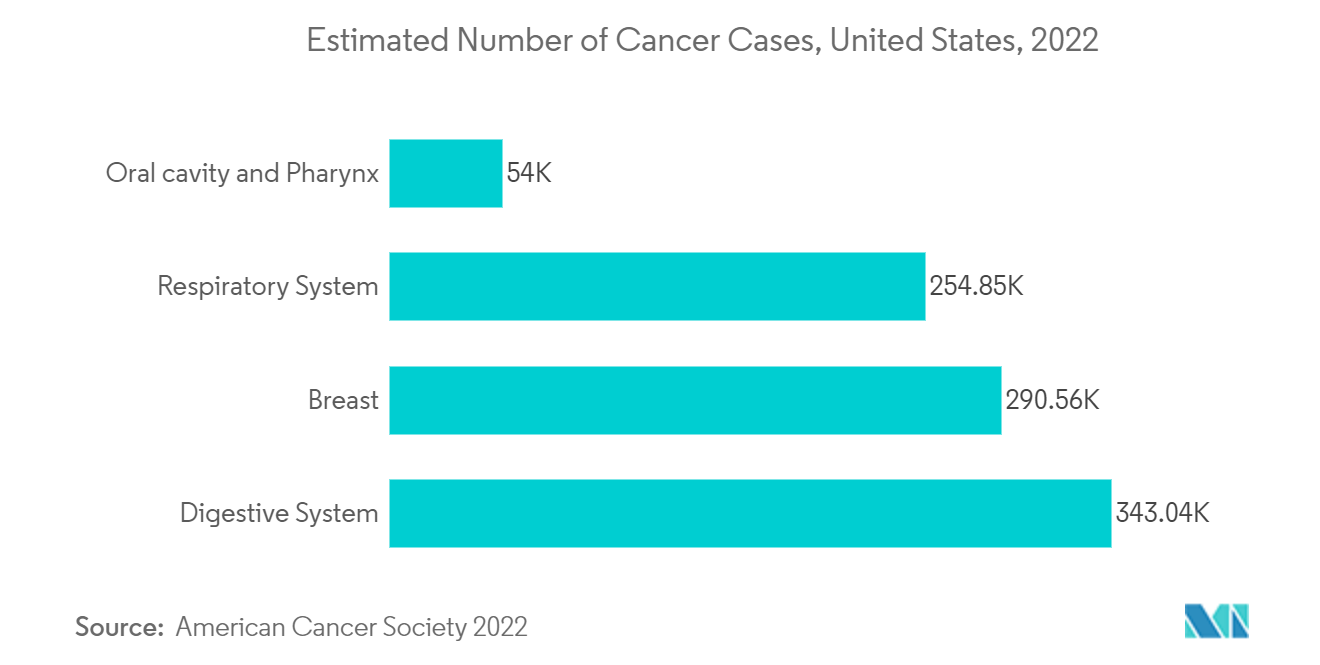
North America Expected to Witness Notable Growth
North America is expected to dominate the overall market throughout the forecast period. The market growth is due to the factors such as the presence of key players, the high prevalence of genetic and infectious diseases in the region, and the established healthcare infrastructure. Furthermore, beneficial government initiatives and an increase in the number of research partnerships are some of the factors that drive market growth. The United States has the maximum share in this region due to supportive healthcare policies, the high number of patients, and a developed healthcare market.
The American Cancer Society estimated about 1.9 million new cancer cases to be diagnosed in the United States in 2022. More than 16.9 million people in the United States were living with a history of cancer and were alive as of 2022. With the rising number of cancer cases across the country, it is believed that the use of HRM analysis will increase, contributing mainly to market growth.
Various government bodies, such as the National Human Genome Research Institute, United States (NHGRI), have been supporting research related to human genome sequencing while funding research related to the genome's structure, function, and role in health and diseases. Moreover, these organizations support studies on genome research's ethical, legal, and social implications (ELSI). Also, the initiation by several general hospitals and other concerned organizations in the area of preventive disease by genomics will complement the market's growth, as well as newer advances and product launches. For instance, in March 2020, the Massachusetts General Hospital announced the launch of new preventive genomics clinics to assist patients in better understanding, preventing, and predicting diseases using their genetic information.
Therefore, with the increasing focus on genomics, the HRM analysis market is expected to witness substantial growth over the forecast period.
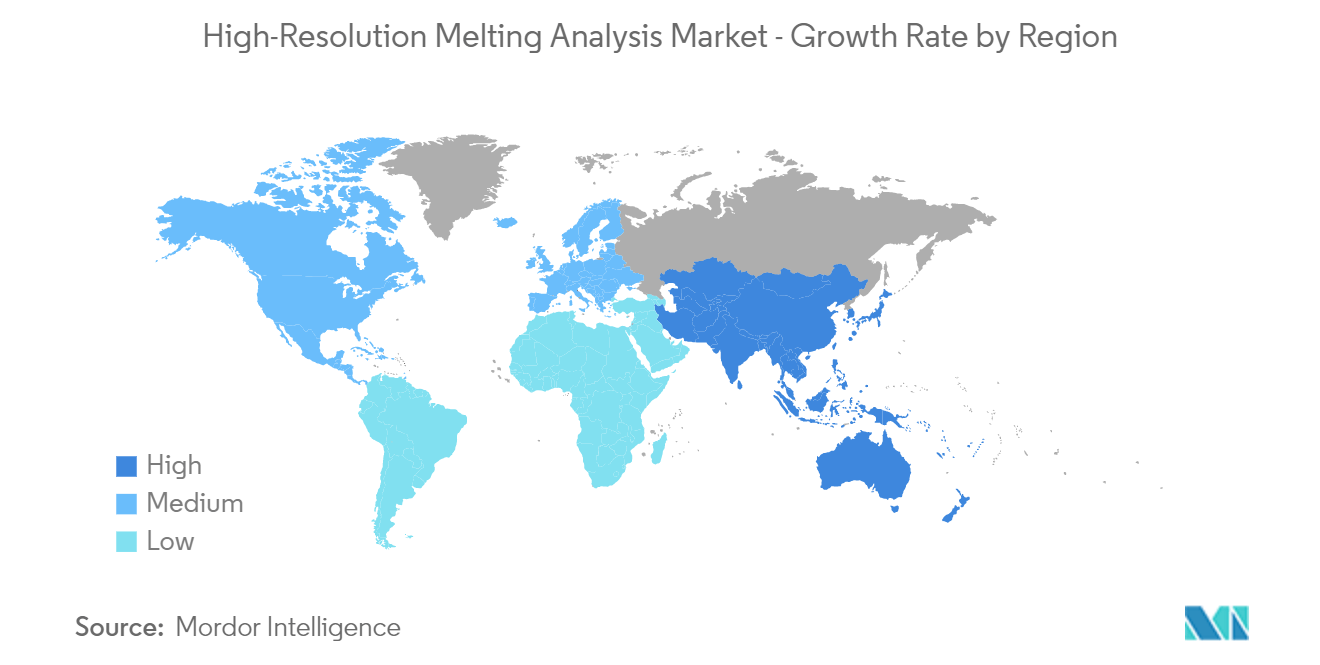
High-Resolution Melting Analysis Industry Overview
The High-Resolution Melting analysis market is moderately competitive and consists of several major players. Some of the international companies which are present in the market are Thermo Fisher Scientific, Inc., Bio-Rad Laboratories, Inc., F. Hoffman-La Roche Ltd, Qiagen NV, Agilent Technologies, Inc., Idaho Technology, Inc., Illumina, Inc., Kapa Biosystems, Azura Genomics, and Canon.
High-Resolution Melting Analysis Market Leaders
-
Thermo Fisher Scientific, Inc.
-
Bio-Rad Laboratories, Inc.
-
F. Hoffman-La Roche Ltd.
-
Qiagen N.V.
-
Agilent Technologies, Inc.
- *Disclaimer: Major Players sorted in no particular order
High-Resolution Melting Analysis Market News
- July 2022: Indonesia's Minister of Health launched a molecular diagnostic kit with High-Resolution Melting (HRM) analysis for colorectal cancer made by Bio Farma.
- May 2022: AMSBIO launched new pathogens detection kits in its portfolio.
High-Resolution Melting Analysis Industry Segmentation
HRM analysis is a relatively new, post-PCR analysis method used to identify variations in nucleic acid sequences. The method is based on detecting small differences in PCR melting curves. It is enabled by improved dsDNA-binding dyes used in conjunction with real-time PCR instrumentation, precise temperature ramp control, and advanced data capture capabilities.
The High-Resolution Melting Analysis Market is Segmented by Product and Service (Reagents and Consumables, Instruments, Software, and Services), Application (SNP Genotyping, Mutation Discovery, Pathogen Identification, and Other Applications), End-user (Research Laboratories and Academic Institutes, Pharmaceutical and Biotechnology Companies, and Other End-users), and Geography (North America, Europe, Asia-Pacific, Middle East, and Africa, and South America). The report offers the value (in USD million) for the above segments.
| By Product and Service | Reagents and Consumables | ||
| Instruments | |||
| Software and Services | |||
| By Application | SNP Genotyping | ||
| Mutation Discovery | |||
| Pathogen Identification | |||
| Other Applications | |||
| By End-user | Research Laboratories and Academic Institutes | ||
| Pharmaceutical and Biotechnology Companies | |||
| Other End-users | |||
| By Geography | North America | United States | |
| Canada | |||
| Mexico | |||
| Europe | Germany | ||
| United Kingdom | |||
| France | |||
| Italy | |||
| Spain | |||
| Rest of Europe | |||
| Asia-Pacific | China | ||
| Japan | |||
| India | |||
| Australia | |||
| South Korea | |||
| Rest of Asia-Pacific | |||
| Middle East and Africa | GCC | ||
| South Africa | |||
| Rest of Middle East and Africa | |||
| South America | Brazil | ||
| Argentina | |||
| Rest of South America | |||
High-Resolution Melting Analysis Market Research FAQs
How big is the High-Resolution Melting Analysis Market?
The High-Resolution Melting Analysis Market size is expected to reach USD 277.04 million in 2025 and grow at a CAGR of 4.31% to reach USD 342.11 million by 2030.
What is the current High-Resolution Melting Analysis Market size?
In 2025, the High-Resolution Melting Analysis Market size is expected to reach USD 277.04 million.
Who are the key players in High-Resolution Melting Analysis Market?
Thermo Fisher Scientific, Inc., Bio-Rad Laboratories, Inc., F. Hoffman-La Roche Ltd., Qiagen N.V. and Agilent Technologies, Inc. are the major companies operating in the High-Resolution Melting Analysis Market.
Which is the fastest growing region in High-Resolution Melting Analysis Market?
Asia Pacific is estimated to grow at the highest CAGR over the forecast period (2025-2030).
Which region has the biggest share in High-Resolution Melting Analysis Market?
In 2025, the North America accounts for the largest market share in High-Resolution Melting Analysis Market.
What years does this High-Resolution Melting Analysis Market cover, and what was the market size in 2024?
In 2024, the High-Resolution Melting Analysis Market size was estimated at USD 265.10 million. The report covers the High-Resolution Melting Analysis Market historical market size for years: 2021, 2022, 2023 and 2024. The report also forecasts the High-Resolution Melting Analysis Market size for years: 2025, 2026, 2027, 2028, 2029 and 2030.
Our Best Selling Reports
High-Resolution Melting Analysis Industry Report
Statistics for the 2025 High-Resolution Melting Analysis market share, size and revenue growth rate, created by Mordor Intelligence™ Industry Reports. High-Resolution Melting Analysis analysis includes a market forecast outlook for 2025 to 2030 and historical overview. Get a sample of this industry analysis as a free report PDF download.

